 Daily
Global Market Outlook
Daily
Global Market Outlook
Worst is Behind Gold Sector
14 March 2003
a currency & gold market analysis
by Ed Bugos
| Print Copy | ||
| Today's Highlights: | ||
| Short & medium term risks to bullish gold sector outlook | ||
| Economic news, pundits, argue for more rate cuts | ||
| Rate cut would work against Fed goals | ||
| FOMC could get support from ECB, SNB | ||
| Platinum leaves other precious metals in the dust | ||
| Gold shares are timely | ||
A wise trader once told me, the market intends on fooling the most amount of people as often as possible.
It sure does. The volatile trading pattern in gold shares has been a constant reinforcer of the notion that it's still worthwhile to take profits and buy the sharp dips.
We're too bullish to trade that way, and besides, we're trying to capture the intermediate and long term trends for you. At some point in this cycle, moreover, just when traders figure they've got a handle on the swings, this gold market's going to go straight up, and the liquidity will be fodder for the bulls. I'd like to think we're near that point, if only because these patterns are becoming increasingly discernible, and tempting to trade.
It's likely the worst of the correction in the gold sector is behind us, but here's a scenario that could extend it a little further yet:
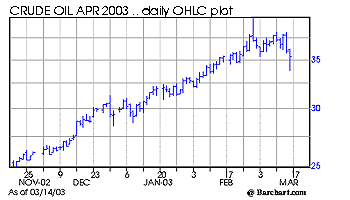 Short
& Medium Term Risks to the Bullish Gold Outlook
Short
& Medium Term Risks to the Bullish Gold Outlook
There is little doubt the deflating war premium has been the main source
of pressure this week, after peaking in February. The corrections in Oil,
Treasuries, US dollar, Dow, and lower low in gold prices must describe
it well (corrections in falling markets mean rallies).
I'm sticking with the model that gold & gold shares led the peak and decline in this premium, as well as predicted the current bounce attempt in the dollar.
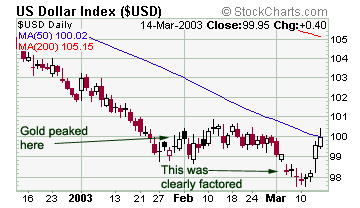 It
seems to make the activity more understandable. In fact, remember that
we couldn't quite reconcile why gold prices weren't stronger when the
US dollar broke down the prior week. Now we know why. That break down
was factored, and the market didn't expect it to continue.
It
seems to make the activity more understandable. In fact, remember that
we couldn't quite reconcile why gold prices weren't stronger when the
US dollar broke down the prior week. Now we know why. That break down
was factored, and the market didn't expect it to continue.
Ignoring fundamentals, the rally in the dollar index has "almost" put a neutral bias into the chart - from a bearish one - with short term implications.
The bulls have to 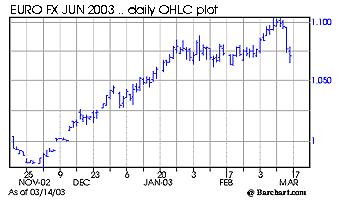 get
it up to about 101 though to be precise. It's
getting its edge from trade against the European currencies and the Australian
dollar this week. Note the almost neutral bias in the Euro (to the right)
and the practically bearish bias in the Pound (below).
get
it up to about 101 though to be precise. It's
getting its edge from trade against the European currencies and the Australian
dollar this week. Note the almost neutral bias in the Euro (to the right)
and the practically bearish bias in the Pound (below).
If the dollar gets past February's high (101) it would argue for a three to four point rally in the short term - to about 104 where it would find intermediate bear market resistance.
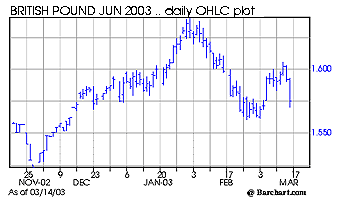 At
any rate, it's difficult to assess how much the war premium will really
shrink.
At
any rate, it's difficult to assess how much the war premium will really
shrink.
I doubt it's all about Iraq, and I have trouble imagining a more peaceful world outlook in the near or medium future regardless of how the Iraq conflict is settled.
Rumors continued to circulate that Iraq's generals are making a surrender plea. Thus, to the extent the outlook can move in the direction of peace, the war premium can shrink. Wouldn't it be nice.
But I can't decide whether the shrinking war premium is a good excuse for the FOMC to lower rates or not next week. A stronger dollar and weaker commodity markets are persuading factors, but the rise in bond yields and the rally in the Dow would need to be constrained... hint, hint.
However, should a Fed rate cut on Tuesday materialize AND have the desired effect on stock prices, it would increase the likelihood the dollar would make its way to 104 (in the index above).
So the risk to our short term bullish outlook for the gold sector would be further declines in the war premium, and/or a bullish Dow/USD reaction to a potential FOMC rate cut.
The risk to our medium term outlook is that we're wrong about the inflation argument. Though to be wrong there, we'd have to see falling stock prices and falling yields manifest in a strong dollar, and a weak commodity complex. Hah, I say, but it's a risk because we might always be overlooking something.
| March 14th, BLS Reports Feb US PPI: Much of the February increase in the Producer Price Index for Finished Goods was due to prices for finished energy goods, which moved up 7.4 percent compared with a 4.8-percent gain in January. Excluding prices for energy goods, the finished goods index decreased 0.3 percent in February. The finished consumer foods index increased 0.6 percent in February, after posting a 1.6-percent gain in the prior month. By contrast, the index for finished goods other than foods and energy turned down 0.5 percent, following a 0.9-percent increase in January. The February decline was largely due to the decrease in the light motor trucks index - US Government Press Release |
Econ News/Kudlow
Argue for Fed Rate Cut
US producer prices shot up 1% in February, after gaining 1.6% in January.
Excluding food and energy, they fell 0.5% after a 0.9% gain in the core
rate in January.
We wouldn't exclude these items, however. My gas bill is a core expenditure. Moreover, the government was able to keep the rise in energy costs out of the data for long enough. The sharp gains we're seeing now are catch-up to reality. Excluding food and energy costs at this point only pushes that reality further away. Just like they like it at the Fed.
US retail sales reportedly dropped 1.6% in February, but much of it was probably due to a 1.2% upward revision in January's number. The declines were broad-based, but "including" the revision, the figure came in about as expected. By contrast, China reported retail sales grew 9.2% year over year between January and February.
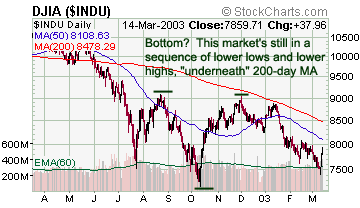 While
I'm writing this, I hear Larry Kudlow (CNBC) in the background telling
viewers that the US stock market has been building a "strong bottom"
since July, and that the PPI report says we have to worry about deflation,
implying the need for a Fed rate cut. Count on Larry to stretch reality
for us.
While
I'm writing this, I hear Larry Kudlow (CNBC) in the background telling
viewers that the US stock market has been building a "strong bottom"
since July, and that the PPI report says we have to worry about deflation,
implying the need for a Fed rate cut. Count on Larry to stretch reality
for us.
How shameful. It's one thing to be bullish but another to lie. Well, maybe he's just stupid. I'd buy that. If this is a strong bottom in the Dow, I'd like to know what a weak one would look like. I've seen weaker bearish patterns than this.
They should appoint Kudlow to head the Treasury's currency policy, if he isn't already on that program. The stuff that comes out of his mouth is sinfully biased. Shame, shame, shame...
But A Rate Cut Would Work Against Fed's
Goals
From the perspective of a gold bull, I don't think it matters one way
or another if the Fed cuts rates. A
rate cut would simply strengthen the long term inflation argument regardless
of what transpires in the immediate aftermath.
That said, I would be skeptical that a rate cut would be met with anything other than a further erosion of confidence in the Fed today. In our view, it would be another wonderful selling opportunity - in equities and the US dollar. Of course, to the extent it does turn out bearish for the dollar, and bullish for commodity prices, it would be bullish for the gold sector, and sooner or later, it would be bearish for bond prices.
There is not a doubt in my mind that the Fed fears precisely that kind of reaction, and if they don't slash rates next week, there can be only two reasons: either this possibility deters them, or they have come to agree that the risks should be weighted towards inflation rather than economic weakness.
That bias is baloney anyway. Inflation "is" economic weakness. They mean to imply deflation, but don't have the nerve to say it, because they know they'd risk a loss in credibility.
The Fed's main challenge is to preserve or recover its credibility. Without it, interest rate cuts are utterly useless to its aim - full employment and low inflation expectations.
Dollar bulls might retort that confidence in Fed policies is still strong, and that there's a six to twelve month lag for the policies to take effect on the economy. Let me correct that. There's a six to twelve month lag for the policies (I doubt that even) to take effect on "prices." To that end, the Fed rate cuts have been quite stimulative of, well, the wrong prices.
As we've intimated recently, the reason their policies aren't working is because they're working on the wrong prices. And the reason that's happening is due to declining market confidence in the Fed's monetary policies.
So our view is that the most bullish thing about next week's FOMC, for dollar bulls, is the anticipation of a rate cut. For, if it comes, it isn't likely to have the intended effect, and if it doesn't come, the markets may get upset quicker.
FOMC May Get Support, ECB
Hence, Tuesday or Wednesday could prove pivotal days for the current short
term trends, especially if the war premium shrinks any further in coming
days.
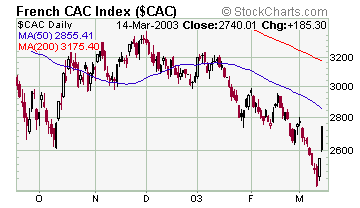 The
ECB has been talking a lot about a rate cut, and the Japanese government
has been putting together a proposal to increase share buy backs in order
to support stock prices.
The
ECB has been talking a lot about a rate cut, and the Japanese government
has been putting together a proposal to increase share buy backs in order
to support stock prices.
An ECB rate cut (and perhaps a Swiss cut as well) could explain the weakness in the European currencies in the latter part of the last week, and it would not surprise me to see the Fed, ECB, and SNB coordinate one, after the other.
So expect a strong push by equity bulls around the globe to lever the falling war premium and support the Fed goal of boosting confidence in dollar assets if it chooses to slash rates.
If not, or especially if it doesn't work, the gold sector should come back like a bat out of hell.
Platinum Leaves Other Precious Metals
Behind
The other precious metals are mixed, technically. Platinum prices remain
relatively strong, after making new all time highs on Monday. But, palladium
prices are toying with five year lows, while Silver prices are developing
a bearish intermediate chart bias.

We're not as concerned with falling Palladium prices as we are with the weakness in Silver. The relative weakness in the latter market has been puzzling, since it's only about 15% off nine year lows, and isn't mired in bearish fundamentals like palladium is.
The silver market has been long overdue for a bull market rally. There should be strong long term support for the market in the $4.28 to $4.38 range, which is about 20 cents lower. Although I'd be surprised to see a test of that level, in light of recent action, it can't be ruled out. Bulls are probably weak in their conviction here.
The holding pattern in gold futures turned out to be a flag, and the break through on the downside could turn the correction into a bearish intermediate chart sequence. The market should be well supported above last week's low at about $332 (nearest contract). In light of recent weakness, this support level will probably see another test yet, though I never would have thought it needed one - still don't.
Gold Shares Are Timely
At any rate, we consider the worst to be behind for gold, as well as gold
shares. The dollar may strengthen in coming days, but I'd be willing to
speculate that gold prices will strengthen too, and begin telegraphing
new lows in the dollar even during any rally in it.
| Gold Shares - Winners & Losers - Friday March 14th, 2003 | ||||
| Best Performers - Friday | Best Performers - 30 days | |||
| Kinross Gold | 9.2% | Tan Range Expl | -1% | |
| Goldenstar Resources | 8.7% | Lihir Gold | -3% | |
| Randgold | 7.5% | Aurizon Mines | -3% | |
| Royal Gold | 4.9% | Ashanti Goldfields | -5% | |
| Eldorado | 4.4% | Newcrest Mining | -6% | |
| The
Averages |
||||
| Friday |
30
days |
|||
| AMEX Gold Bugs | 3.3% | AMEX Gold Bugs | -15% | |
| BGI Gold Index | 4.2% | BGI Gold Index | -16% | |
| XAU | 2.5% | XAU | -14% | |
| Worst Performers - Friday | Worst Performers - 30 days | |||
| Lihir Gold | -2.9% | Royal Gold | -49% | |
| Sons of Gwalia | -1.5% | Sons of Gwalia | -34% | |
| Newcrest Mining | -1.0% | Gabriel Resources | -32% | |
| Gabriel Resources | 0.0% | Meridian Gold | -30% | |
| Durban Deep | 0.4% | Durban Deep | -28% | |
At their worst this past week, gold shares factored a gold price of just under $300 / ounce.
I could imagine further downside only to the extent of further tests of the aforementioned support in the gold prices, or a much more inspiring corrective rally on Wall Street than we imagine right now.
If the current upswing in the Dow still looks tentative by Tuesday/Wednesday, I'd say the best buys in the gold shares will have left the station.
So for investors that have yet to enter the gold sector, or for those that have taken profits during January's run, we rate the stocks in our proprietary index a timely buy - as timely or more than at any time since the dollar peaked in 2001.
Note the charts below (fundamentals on the left, technicals on the right).
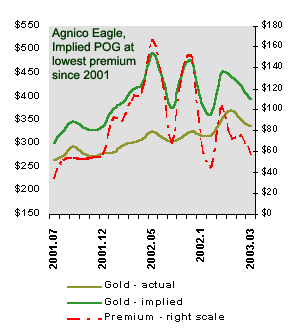 |
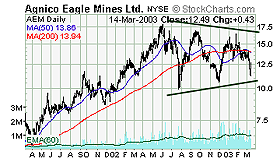 |
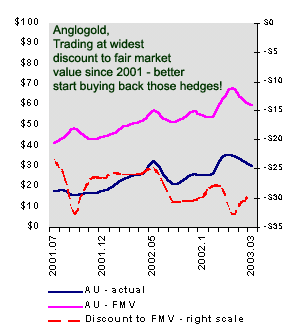 |
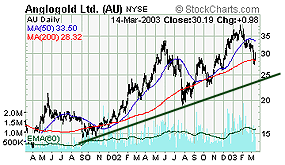 |
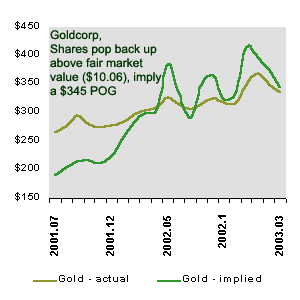 |
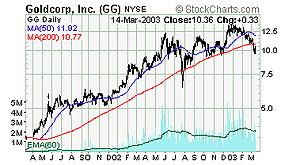 |
Have a good weekend.